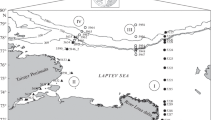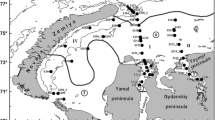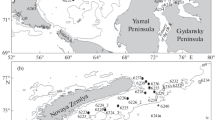Abstract
The vertical distribution of phytoplankton primary production (PP) and chlorophyll a (Chl) was studied based on the data carried out in August–September 2015, 2017, and 2018. The PP maximum was located at the surface or within the 0–5 m subsurface layer. The subsurface chlorophyll maximum (SCM) was recorded at 39% stations on the outer shelf and in the vicinity of the continental slope. The SCM was not detected along the northward transect (130° E) from the Lena River delta. As in other areas of the World Ocean, the SCM was located below the upper mixed layer (UML), in the nitracline, near the boundary of the euphotic zone (1% of photosynthetically active radiation). Generally, the SCM was not accompanied by an additional PP maximum. The Chl concentration at the SCM did not exceed 1 mg m–3. PP produced within the UML and SCM contributed 72 and 23%, respectively, to the integrated primary production (IPP) of the water column. Our results suggest that the influence of the SCM on IPP was insufficient due to low Chl concentration and PP colimitation by the low light and temperature at these depths.







Similar content being viewed by others
REFERENCES
V. I. Vedernikov, “Specific distribution of primary production and chlorophyll in the Black Sea in spring and summer,” in Variability of the Black Sea Ecosystem: Natural and Anthropogenic Factors, Ed. by M. E. Vinogradov (Nauka, Moscow, 1991), pp. 128–147.
A. B. Demidov, V. I. Gagarin, E. G. Arashkevich, et al., “Spatial variability of primary production and chlorophyll in the Laptev Sea in August–September,” Oceanology (Engl. Transl.) 59, 678–691 (2019).
I. N. Sukhanova, M. V. Flint, E. Ju. Georgieva, et al., “The structure of phytoplankton communities in the eastern part of the Laptev Sea,” Oceanology (Engl. Transl.) 57, 75–90 (2017).
S. H. Ahn, T. Whitledge, D. A. Stockwell, et al., “The biochemical composition of phytoplankton in the Laptev and East Siberian seas during the summer of 2013,” Polar Biol. 42 (1), 133–148 (2019).
M. Ardyna, M. Babin, M. Gosselin, et al., “Parameterization of vertical chlorophyll a in the Arctic Ocean: impact of the subsurface chlorophyll maximum on regional, seasonal and annual primary production estimates,” Biogeosciences 10 (3), 1345–1399 (2013).
K. R. Arrigo, P. A. Matrai, and G. L. van Dijken, “Primary productivity in the Arctic Ocean: Impacts of complex optical properties and subsurface chlorophyll maxima on large-scale estimates,” J. Geophys. Res.: Oceans 116, C11022 (2011). https://doi.org/10.1029/2011JC007273
K. R. Arrigo and G. L. van Dijken, “Secular trends in Arctic Ocean net primary production,” J. Geophys. Res.: Oceans 116, C09011 (2011). https://doi.org/10.1029/2011JC007151
M. Babin, S. Bélanger, I. Ellingsen, et al., “Estimating of primary production in the Arctic Ocean using ocean color remote sensing and coupled physical-biological models: strengths, limitations and how they compare,” Progr. Oceanogr. 139, 197–220 (2015).
M. J. Behrenfeld and P. G. Falkowski, “A consumer’s guide to phytoplankton primary productivity models,” Limnol. Oceanogr. 42, 1479–1491 (1997).
P. S. Bhavya, J. H. Lee, H. W. Lee, et al., “First in situ estimations of small phytoplankton carbon and nitrogen uptake rates in the Kara, Laptev and East Siberian seas,” Biogeosciences 15 (18), 5503–5517 (2018).
B. C. Booth, P. Larouche, S. Bélanger, et al., “Dynamics of Chaetoceros socialis in the north water,” Deep Sea Res., Part II 49 (22–23), 5003–5025 (2002).
Z. W. Brown, K. E. Lowry, M. A. Palmer, G. L. van Dijken, M. M. Mills, R. S. Pickart, and K. R. Arrigo, “Characterizing the subsurface chlorophyll a maximum in the Chukchi Sea and Canada Basin,” Deep Sea Res., Part II 118, 88–104 (2015).
J. Campbell, D. Antoine, R. Armstrong, et al., “Comparison of algorithms for estimating ocean primary production from surface chlorophyll, temperature, and irradiance,” Global Biogeochem. Cycles 16, (2002). https://doi.org/10.1029/2001GB001444
M.-E. Carr, M. A. M. Friedrichs, M. Schmeltz, et al., “A comparison of global estimates of marine primary production from ocean color,” Deep Sea Res., Part II 53, 741–770 (2006).
E. C. Carmack, R. W. Macdonald, and S. Jasper, “Phytoplankton productivity on the Canadian Shelf of the Beaufort Sea,” Mar. Ecol.: Progr. Ser. 277, 37–50 (2004).
A. Cherkasheva, E. M. Nöthig, E. Bauerfeind, C. Melsheimer, and A. Bracher, “From the chlorophyll-a in the surface layer to its vertical profile: a Greenland Sea relationship for satellite applications,” Ocean Sci. 9, 431–445 (2013).
G. F. Cota, L. R. Pomeroy, W. G. Harrison, et al., “Nutrients, primary production and microbial heterotrophy in the southeastern Chukchi Sea: Arctic summer nutrient depletion and heterotrophy,” Mar. Ecol.: Progr. Ser. 135, 247–258 (1996).
J. J. Cullen, “Subsurface chlorophyll maximum layers: enduring enigma or mystery solved?” Annu. Rev. Mar. Sci. 7, 207–239 (2015).
A. B. Demidov, V. I. Gagarin, O. V. Vorobieva, et al., “Spatial and vertical variability of primary production in the Kara Sea in July and August 2016: the influence of the river plume and subsurface chlorophyll maxima,” Polar Biol. 41 (3), 563–578 (2018).
A. B. Demidov, O. V. Kopelevich, S. A. Mosharov, et al., “Modeling Kara Sea phytoplankton primary production: development and skill assessment of regional algorithms,” J. Sea Res. 125, 1–17 (2017).
A. B. Demidov, S. A. Mosharov, and P. N. Makkaveev, “Patterns of the Kara Sea primary production in autumn: biotic and abiotic forcing of subsurface layer,” J. Mar. Sys. 132, 130–149 (2014).
S. R. Erga, N. Ssebionga, B. Hamre, et al., “Environmental control of phytoplankton distribution and photosynthetic performance at the Jan Mayen Front in the Norwegian Sea,” J. Mar. Sys. 130, 193–205 (2014).
J. Ferland, M. Gosselin, and M. Starr, “Environmental control of summer primary production in the Hudson Bay system: the role of stratification,” J. Mar. Sys. 88, 385–400 (2011).
M. A. M. Friedrichs, M.-E. Carr, R. Barber, et al., “Assessing the uncertainties of model estimates of primary productivity in the tropical Pacific Ocean,” J. Mar. Sys. 76, 113–133 (2009).
H. G. Gordon and A. Morel, Remote Assessment of Ocean Color for Interpretation of Satellite Visible Imagery: A Review (Springer-Verlag, New York, 1983).
H. P. Hansen and F. Koroleff, “Determination of nutrients, in Methods of Seawater Analysis, Ed. by K. Grashoff, (Wiley, Chichester, 1999), pp. 149–228.
A.-S. Heiskanen and A. Keck, “Distribution and sinking rates of phytoplankton, detritus and particulate biogenic silica in the Laptev Sea and Lena River (Arctic Siberia),” Mar. Chem. 53, 229–245 (1996).
V. Hill and G. Cota, “Spatial patterns of primary production on the shelf, slope and basin of the Western Arctic in 2002,” Deep Sea Res., Part II 57 (24–26), 3344–3354 (2005).
V. J. Hill, P. A. Matrai, E. Olson, et al., “Synthesis of integrated primary production in the Arctic Ocean: II. In situ and remotely sensed estimates,” Progr. Oceanogr. 110, 107–125 (2013).
O. Holm-Hansen, C. J. Lorenzen, R. W. Holmes, and J. D. H. Strickland, “Fluorometric determination of chlorophyll,” J. Cons. Perm. Int. Explor. Mer. 30, 3–15 (1965).
O. Holm-Hansen and B. Riemann, “Chlorophyll a determination: improvements in methodology,” Oikos 30, 438–447 (1978).
H. G. Jerlov, Optical Oceanography (Elsevier, New York, 1968).
M. Jin, C. Deal, S. H. Lee, et al., “Investigation of Arctic sea and ocean primary production for the period 1992–2007 using a 3-D global ice-ocean ecosystem model,” Deep Sea Res., Part II 81–84, 28–35 (2012).
K. V. Juterzenka and K. Knickmeier, “Chlorophyll a distribution in water column and sea ice during the Laptev Sea freeze-up study in autumn 1995,” in Land-Ocean Systems in the Siberian Arctic: Dynamics and History, Ed. by H. Kassens, (Springer, Berlin, 1999), pp. 153–160.
Y. J. Lee, P. A. Matrai, M. A. M. Friedrichs, et al., “An assessment of phytoplankton primary productivity in the Arctic Ocean from satellite ocean color/in situ chlorophyll-a based models,” J. Geophys. Res.: Oceans 120, (2015). https://doi.org/10.1002/2015/JC11018
W. W. Li, “Photosynthetic response to temperature of marine phytoplankton along a latitudinal gradient (16°N to 74°N),” Deep-Sea Res., Part A 32 (11), 1381–1391 (1985).
S. E. Lohrenz, “Estimation of primary production by the simulated in situ method,” ICES Mar. Sci. Symp. 197, 159–171 (1993).
P. N. Makkaveev, “The total alkalinity in the anoxic waters of the Black sea and in sea-river mixture zones,” in Proceedings of the Joint IOC-JGOFS CO2Advisory Panel Meeting (Intergovernmental Oceanographic Commission, UNESCO, Paris, 1998).
J. Martin, D. Dumont, and J.-E. Tremblay, “Contribution of subsurface chlorophyll maxima to primary production in the coastal Beaufort Sea (Canadian Arctic): a model assessment,” J. Geophys. Res. 118 (11), 5873–6318 (2013).
J. Martin, J.-E. Tremblay, J. Gagnon, et al., “Prevalence, structure and properties of subsurface chlorophyll maxima in Canadian Arctic waters,” Mar. Ecol.: Progr. Ser. 412, 69–84 (2010).
J. Martin, J.-E. Tremblay, and N. M. Price, “Nutritive and photosynthetic ecology of subsurface chlorophyll maxima in Canadian Arctic waters,” Biogeosciences 9 (12), 5353–5371 (2012).
K. I. Martini, P. J. Stabeno, and C. Ladd, “Dependence of subsurface chlorophyll on seasonal water masses in the Chukchi Sea,” J. Geophys. Res.: Oceans 121, 1755–1770 (2016). https://doi.org/10.1002/2015JC011359
F. A. McLaughlin and E. C. Carmack, “Deepening of the nutricline and chlorophyll maximum in the Canada Basin interior, 2003–2009,” Geophys. Res. Lett. 37, L24602 (2010). https://doi.org/10.1029/2010GL045459
F. J. Millero, “Thermodynamics of the carbon dioxide system in oceans,” Geochim. Cosmochim. Acta 59 (4), 661–677 (1995).
A. Morel and J.-F. Berthon, “Surface pigments, algal biomass profiles, and potential production of the euphotic layer: relationships reinvestigated in view of remote-sensing applications,” Limnol. Oceanogr. 34 (1), 1545–1562 (1989).
S. Pabi, G. L. van Dijken, and K. R. Arrigo, “Primary production in the Arctic Ocean, 1998–2006,” J. Geophys. Res.: Oceans 113, C08005 (2008). https://doi.org/10.1029/2007/JC004578
T. Platt, W. G. Harrison, B. Irwin, et al., “Photosynthesis and photoadaptation of marine phytoplankton in the Arctic,” Deep-Sea Res. 29 (10), 1159–1170 (1982).
T. Platt, S. Sathyendranath, O. Ulloa, et al., “Ocean primary production and available light: further algorithms for remote sensing,” Deep Sea Res., Part I 35, 855–879 (1988).
E. E. Popova, A. Yool, A. C. Coward, et al., “Control of primary production in the Arctic by nutrients and light: insights from a high resolution ocean general circulation model,” Biogeosciences 7 (11), 3569–3591 (2010).
E. E. Popova, A. Yool, A. C. Coward, et al., “What controls primary production in the Arctic Ocean? Results from an intercomparison of five general circulation models with biogeochemistry,” J. Geophys. Res.: Oceans 117, C00D12 (2012). https://doi.org/10.1029/2011JC007112
J. H. Ryther and C. S. Yentsch, “The estimation of phytoplankton production in the ocean from chlorophyll and light data,” Limnol. Oceanogr. 2, 281–286 (1957).
V. Saba, M. A. M. Friedrichs, D. Antoine, et al., “An evaluation of ocean color model estimates of marine primary productivity in coastal and pelagic regions across the globe,” Biogeosciences 8, 489–503 (2011).
V. Saba, S. Marjorie, M. A. M. Friedrichs, et al., “Challenges of modeling depth-integrated marine primary productivity over multiple decades: a case study at BATS and HOT,” Global Biogeochem. Cycles 24, GB3020 (2010). https://doi.org/10.1029/2009GB003655
V. Schourup-Kristensen, C. Wekerle, D. A. Wolf-Gladrow, and C. Völker, “Arctic Ocean biogeochemistry in the high resolution FESOM 1.4-REcoM2 model,” Progr. Oceanogr. 168, 65–81 (2018).
W. O. Smith and W. G. Harrison, “New production in polar regions: the role of environmental controls,” Deep-Sea Res. 38 (12), 1463–1479 (1991).
Yu. I. Sorokin and P. Yu. Sorokin, “Plankton and primary production in the Lena river estuary and in the south-eastern Laptev Sea,” Estuarine, Coastal Shelf Sci. 43, 399–418 (1996).
E. Steemann Nielsen, “The use of radioactive carbon (C14) for measuring organic production in the sea,” J. Cons. Perm. Ins. Explor. Mer. 18, 117–140 (1952).
E. Steemann Nielsen, “Experimental methods for measuring organic production in the sea,” Rapp. P.-v. Réun. Cons. perm. int. Explor. Mer. 144, 38–46 (1958).
N. S. Steiner, T. Sou, C. Deal, et al., “The future of the subsurface chlorophyll-a maximum in the Canada Basin—A model intercomparison,” J. Geophys. Res.: Oceans 121, 387–409 (2015). https://doi.org/10.1002/2015JC011232
M. L. Timmermans, S. Cole, and J. Toole, “Horizontal density structure and restratification of the Arctic Ocean surface layer,” J. Phys. Oceanogr. 42 (4), 659–668 (2012).
J.-É. Tremblay, C. Michel, and K. A. Hobson, “Bloom dynamics in early opening waters of the Arctic Ocean,” Limnol. Oceanogr. 51 (2), 900–912 (2006).
J.-É. Tremblay, K. Simpson, J. Martin, et al., “Vertical stability and the annual dynamics of nutrients and chlorophyll fluorescence in the coastal, southeast Beaufort Sea,” J. Geophys. Res.: Oceans 113, C07S90 (2008). https://doi.org/10.1029/2007JC004547
K. Tuschling, “Phytoplankton ecology in the arctic Laptev Sea—a comparison of three seasons,” Ber. Polarforschung. 347, (2000).
J. Uitz, H. Claustre, A. Morel, and S. B. Hooker, “Vertical distribution of phytoplankton communities in open ocean: an assessment on surface chlorophyll,” J. Geophys. Res.: Oceans 111, C08005 (2006). https://doi.org/10.1029/2005JC003207
Funding
This work was performed according to the State assignment of Ministry of Science and Higher Education of Russian Federation (no. 0149-2019-0008). Collection of phytoplankton data was supported by the Russian Foundation of Basic Research, project no. 18-05-60069. Collection of hydrophysical data was supported by the Russian Foundation for Basic Research, project no. 18-05-60302.
Author information
Authors and Affiliations
Corresponding author
Additional information
Translated by N. Ruban
Rights and permissions
About this article
Cite this article
Demidov, A.B., Gagarin, V.I., Artemiev, V.A. et al. Vertical Variability of Primary Production and Features of the Subsurface Chlorophyll Maximum in the Laptev Sea in August–September, 2015, 2017, and 2018. Oceanology 60, 189–204 (2020). https://doi.org/10.1134/S0001437020010063
Received:
Revised:
Accepted:
Published:
Issue Date:
DOI: https://doi.org/10.1134/S0001437020010063




